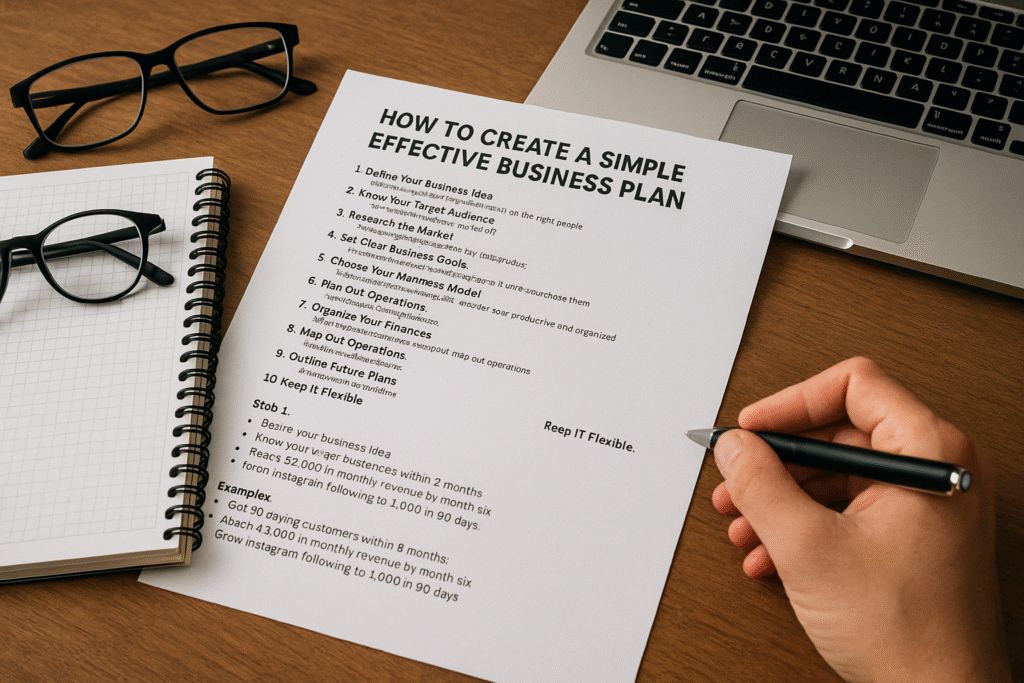A business plan isn’t just for investors—it’s for you. It’s a roadmap that helps you stay focused, make smarter decisions, and measure progress. Even if you’re starting a small online business or a side hustle, having a plan increases your chances of success dramatically.
Here’s how to create a practical, no-fluff business plan—step by step.
Why You Need a Business Plan
Many new entrepreneurs skip this step, thinking it’s only for big companies. But a business plan helps you:
- Clarify your vision and goals
- Identify your target market and competitors
- Plan your budget and revenue
- Stay organized and focused
It doesn’t have to be 50 pages long. Even a 1–2 page plan is enough to guide your early actions.
Step 1: Write Your Executive Summary
This is a short overview of your business. It should include:
- What your business does
- Who it serves
- What makes it unique
- Your short-term and long-term goals
Example:
“GreenBox is an eco-friendly subscription box service for busy urban professionals who want to reduce plastic waste. Our mission is to make sustainable living easy and stylish.”
Step 2: Define Your Business Model
Clearly outline how your business makes money. Common models include:
- Product sales (physical or digital)
- Services (coaching, consulting, freelancing)
- Subscriptions
- Affiliate marketing
- Advertising
Also mention your pricing strategy and how you’ll deliver value to customers.
Step 3: Identify Your Target Market
Answer these questions:
- Who is your ideal customer?
- What are their biggest pain points?
- Where do they spend time online?
- What motivates their buying decisions?
Use demographic and psychographic info to create a detailed customer profile.
Step 4: Analyze the Competition
Understanding your competitors helps you differentiate yourself. For each main competitor, analyze:
- What they offer
- Their strengths and weaknesses
- Pricing
- Customer reviews
- Marketing strategies
Ask: What gap can I fill that they don’t?
Step 5: Describe Your Product or Service
Now explain what you’re selling:
- What problem does it solve?
- What are its key features or benefits?
- Why is it better (or different) from other options?
If you have future products or upgrades planned, mention those too.
Step 6: Marketing and Sales Strategy
How will you attract and convert customers? Your plan should include:
- Marketing channels (e.g., Instagram, SEO, email marketing)
- Content strategy
- Promotional tactics (e.g., discounts, partnerships)
- Sales funnel stages (how leads become buyers)
Example:
“We’ll build an email list through lead magnets and convert subscribers with a weekly newsletter and product demos.”
Step 7: Set Your Financial Plan
Even basic financial projections can help you stay grounded. Include:
- Startup costs (website, tools, inventory)
- Monthly expenses (software, ads, freelancers)
- Revenue goals
- Break-even point
- Funding needs (if any)
You don’t need to be an accountant—just be realistic and use tools like Excel or Google Sheets.
Step 8: Operations and Logistics
Detail how your business will run day-to-day. Consider:
- How products/services will be delivered
- What tools or software you’ll use
- Who will handle what (if you’re working with others)
- Legal structure (sole proprietorship, LLC, etc.)
The simpler your operations in the beginning, the better.
Step 9: Set Measurable Goals
Define your short-term (3–6 months) and long-term (1–3 years) goals. These might include:
- Revenue milestones
- Email subscribers
- Product launches
- Social media followers
Make your goals SMART:
- Specific
- Measurable
- Achievable
- Relevant
- Time-bound
Step 10: Review and Adjust Regularly
Your business plan isn’t static—it should evolve as your business grows. Set a reminder to review it monthly or quarterly and make updates based on:
- What’s working
- New insights
- Customer feedback
- Market trends
Flexibility is key to long-term success.
Bonus Tip: Use a Template or Canvas
If you’re more visual, try tools like:
- Lean Canvas
- Business Model Canvas
- Notion business plan templates
These help you stay organized without overwhelming you with too much detail.
Final Thought: Plan, Then Act
Planning alone won’t build your business—but it will help you avoid chaos, reduce risk, and stay on track. A solid business plan is like a GPS: you can always take detours, but you’ll never forget where you’re going.
So take the time to write your plan. Even a few pages can make a world of difference.
Mais um artigo pronto! Já preparando o próximo para manter o ritmo e garantir o volume necessário para a aprovação no Google AdSense. Vamos seguir!

